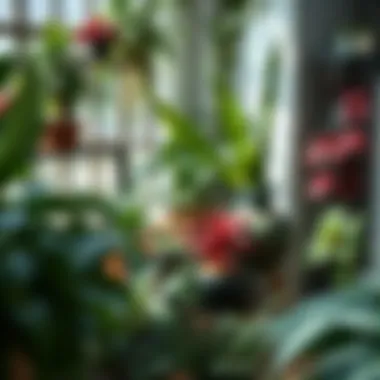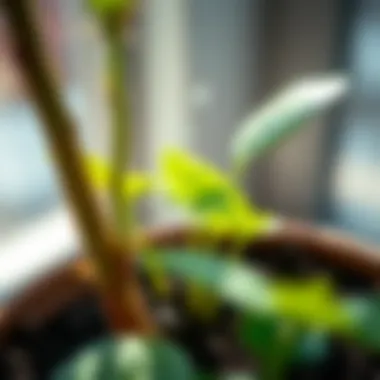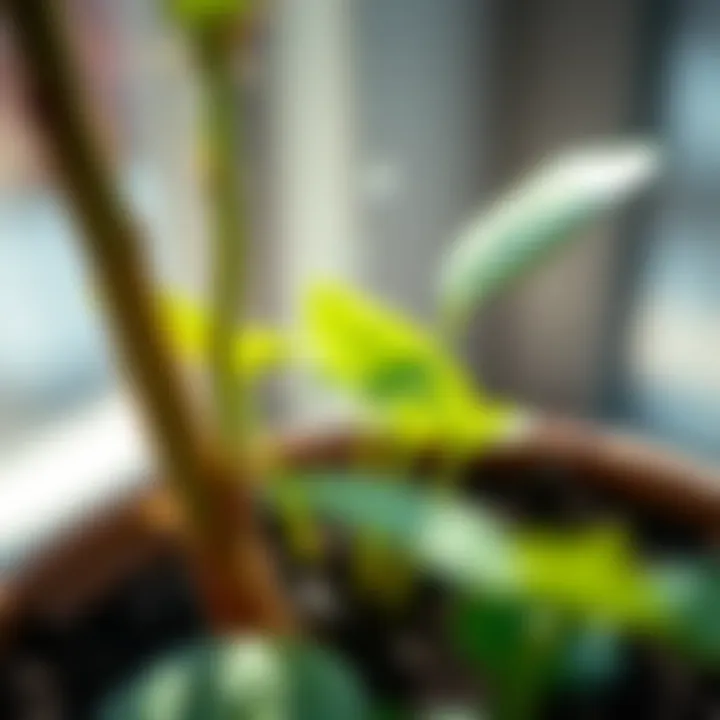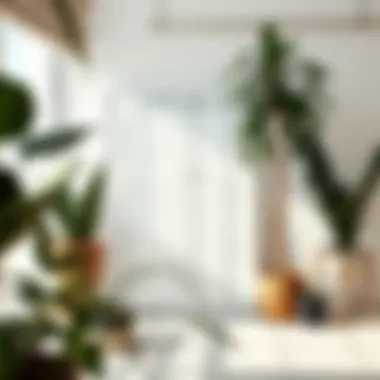Mastering Indoor Plant Watering Techniques


Intro
Indoor plants bring life and vitality into our homes, creating charming aesthetics while improving air quality. Understanding how to meet their watering needs is crucial for their longevity and health. Overwatering or underwatering can both spell disaster, leading to wilting leaves or root rot. This article aims to shed light on the various factors that influence how often and how much water your plants need, catering specifically to housewives and homeowners keen on creating vibrant green spaces. We will explore plant types, environmental conditions, and practical watering techniques for optimal soil moisture management.
Gardening enthusiasts may wonder, "How do I keep my ferns lush without making them soggy?" or, "Why does my succulent seem to be thirsting?" These questions are common among plant parents, and getting to the bottom of them is a journey worth undertaking.
To add depth to our understanding, we delve into the differences among plant families, focusing on their individual needs. From cacti that thrive in drought to leafy tropical plants that revel in humidity, learning about what suits each variety goes a long way. Let's unravel the intricate tapestry of plant care together, ensuring that our indoor green friends flourish and brighten our living spaces.
The Importance of Proper Watering
Watering indoor plants may seem straightforward, but getting it right is crucial for their health and well-being. Understanding this essential aspect can significantly influence your plants’ growth, vitality, and aesthetic appeal in your living space. Proper watering is about striking a balance. If you want your indoor plants to thrive, a consistent approach to watering will pay off.
Understanding Plant Physiology
Plants require water not solely for hydration but as a vehicle for nutrients. Take the humble spider plant, for example. It absorbs moisture through its roots, which then flow upwards to nourish the leaves and stems. Ever noticed how leaves appear droopy when a plant is under-watered? This is due to the lack of water pressure, which keeps them sturdy. Just as we rely on fluids for various bodily functions, plants depend on them to photosynthesize, develop new leaves, and flower. Essentially, without adequate water, even the hardiest plant will struggle.
Consider also how different plants have adapted to their environments. For instance, the snake plant is a champion at retaining water thanks to its thick leaves, enabling it to survive in less-than-ideal conditions. Understanding these physiological traits is crucial for tailoring your watering practices to suit each plant’s specific needs. Evaluating how each plant physiology works guides you in fostering an environment where they can flourish.
Consequences of Overwatering and Underwatering
Neglecting the importance of proper watering can lead to dire consequences. Both overwatering and underwatering are like two sides of the same coins, both can spell disaster for indoor plants.
Overwatering can suffocate the roots, blocking air from reaching them. Think of it as drowning—roots need oxygen just like we do! Common symptoms of overwatered plants include yellowing leaves, mold growth, and wilting. A staggering fact: it’s estimated that about 90% of plant deaths can be traced back to overwatering. It’s a mistake that’s easy to make, especially for novice plant parents.
On the flip side, underwatering introduces its own set of problems. A telltale sign is when leaves turn crispy or brown, signaling that the plant is not getting enough moisture. Sluggish growth and leaf drop are also common. If a plant is consistently underwatered, there’s a risk of roots dying, leading to permanent damage to the plant’s health.
“Watering isn't just a chore; it's an art that you master over time.”
In short, both scenarios can trap a houseplant owner in a cycle of stress and disappointment. And let’s face it, it can be downright disheartening to watch a beloved plant wither away despite your best efforts. By being mindful of a plant's watering requirements and understanding the consequences of missteps, you pave the way for healthier, more vibrant indoor plants.
In this article, we will explore the various factors influencing watering frequency and practical methods to assess soil moisture, to ensure that your indoor garden truly thrives.
Factors Influencing Watering Frequency
Watering frequency is not a one-size-fits-all concept. Just like you can't use the same recipe for every dish, the watering needs of your indoor plants depend on various factors. Understanding these elements allows homeowners to create a thriving indoor garden, ensuring plants receive the right amount of water not too much and not too little. This section will explore the nuances of watering and how specific factors play into the equation.
Plant Type and Growth Habit
Different plants have vastly different requirements when it comes to water. For instance, succulents like Aloe Vera or Echeveria store water in their leaves and can thrive with minimal watering. Conversely, tropical plants such as Peace Lilies or Fiddle Leaf Figs demand consistent moisture to stay healthy.
Additionally, the growth habit of a plant also plays a role. Fast-growing plants typically absorb water quicker, needing more frequent watering than slower-growing varieties. Reviewing the origin of the plant can provide insight into its natural habitat and, thereby, its watering needs. Plants accustomed to arid environments are equipped to survive extended dry spells, while those from rainforests thrive in consistently moist conditions.
Seasonal Changes and Growth Cycles
Seasonality brings its own set of watering challenges. During spring and summer months, most plants are actively growing and will require more frequent watering. This growth spurt often leads to a spike in water intake, which can catch many house owners off guard.
In contrast, during the fall and winter months, many plants enter a dormant phase, slowing their growth and lessening their water requirements. It’s essential to adjust your watering schedule appropriately during these shifts. Keeping an eye on your plants’ overall health during each season will help you be mindful of their changing needs.
Light Exposure and Temperature


Light is a crucial player in the watering game. Plants that receive bright, direct sunlight typically require more water than those in shaded environments. For instance, a Snake Plant basking in high light will dry out faster than a Pothos tucked away in a dim corner. Similarly, temperature also plays a pivotal role in moisture evaporation. Higher temperatures can lead to quicker water loss from both the soil and the plant itself.
A good rule of thumb is to monitor your plant’s position and adjust the watering schedule based on how much sun it receives. If you notice yellowing leaves or droopiness, it might be a sign that the plant isn't getting the right amount of moisture relative to its light exposure.
Humidity Levels in Your Living Space
Humidity levels can be a double-edged sword. High humidity can benefit many tropical plants, allowing for better water retention in the soil. However, in low humidity environments, these same plants might suffer from moisture loss, necessitating more frequent watering.
To accurately gauge humidity levels, you can use a hygrometer, a handy tool that measures moisture in the air. If your living area is on the drier side, consider misting your plants or utilizing a humidifier to maintain the right environment. This added care can make a world of difference, especially for plants that aren’t accustomed to the desert-like conditions.
"Understanding the nuances of your indoor plants’ requirements is like tuning an instrument; each needs its own adjustments for perfect harmony."
In summary, becoming attuned to the specific watering needs requires practice and a keen eye for detail. However, by accounting for factors such as plant type, seasonal changes, light exposure, and humidity levels, homeowners can ensure their indoor plants not only survive but thrive.
Assessing Soil Moisture
Assessing the moisture content of the soil is a fundamental aspect of nurturing indoor plants. Understanding how to gauge soil moisture properly can make a world of difference in the health and vitality of your greenery. It's not just about grabbing a watering can and giving your plants a drink; it’s about knowing precisely when that drink is needed. If you want your indoor garden to thrive, checking soil moisture should be at the top of your to-do list.
Recognizing when to water involves observing various signs in both the plant and the soil. Overwatering can lead to issues such as root rot, while underwatering causes wilting and stunted growth. Therefore, mastering the skill of assessing soil moisture can help you avoid these pitfalls. Furthermore, it fosters a deeper connection to your plants as you become attuned to their unique needs.
Visual Inspection Techniques
One straightforward method for gauging soil moisture is visual inspection. This entails taking a good look at both the soil surface and the plant itself. Start off with observing the soil's color. Wet soil tends to be darker, while dry soil appears lighter. You can also look for cracks on the surface, which indicate dryness.
Don’t forget to keep an eye on the leaves of your plants. For example, if you see drooping leaves or yellowing—those are clear signs that your plant may be thirsty or, conversely, suffering from too much water. This approach allows you to assess the moisture level at a glance without needing any fancy tools.
Here are some quick tips for visual inspection:
- Color of the soil: Dark soil usually means it's moist; light soil indicates dryness.
- Surface cracks: If you see cracks in the soil surface, it’s likely dry.
- Leaf condition: Drooping or yellowing leaves can mean water issues.
Using Soil Moisture Meters
For a more precise approach, consider using soil moisture meters. These handy tools take the guesswork out of watering by providing a visual gauge of soil moisture levels. Simply insert the probe into the soil and read the measurement displayed on the dial.
Soil moisture meters can be especially useful for those who may not have a natural instinct for plant care or who manage multiple plants with varying needs. They come handy, particularly for plants like ferns that require consistent moisture,
Looking for a good one? Ensure it’s simple to use, and make sure to calibrate it properly for accurate readings.
Finger Test Methodology
If you prefer a more hands-on approach, the finger test can be quite effective. It's simple and effective: stick your index finger about an inch into the soil. If your finger comes out clean and dry, it’s time to water. If it’s still moist, your plant is likely okay for a little while longer.
This method is incredibly intuitive. Not only does it give you a tactile sense of the soil, but it also helps reinforce your connection with your plants. Doing this periodically encourages attentiveness to your plant's needs. Remember to check different spots in the pot, as moisture can be uneven.
Watering Techniques for Indoor Plants
Watering techniques play a critical move in ensuring that indoor plants thrive and adorn our homes with lush greenery. Not only does proper watering directly affect plant health, but various methods can also improve efficiency, reduce water wastage, and simplify the care routine for plant owners. As you adjust your watering regimen, it’s essential to understand various techniques that can accommodate the distinct needs of your indoor flora. Embracing the right approach will help you cater specifically to each type of plant, ensuring their moisture requirements are met without unnecessary fuss.
Drip Irrigation Systems
Drip irrigation systems provide a systematic way of delivering water directly to the roots of your indoor plants. These setups can range from sophisticated automated systems to simple DIY solutions. The real beauty of drip irrigation lies in its efficiency. By directing water exactly where it’s needed, it minimizes evaporation and runoff.


Many plant lovers find that less time spent watering yields healthier plants. Imagine not needing to worry about overwatering, as this method allows for precise control over hydration levels. Moreover, drip irrigation can be particularly useful for those who travel or have busy schedules. The system can be set up on a timer, ensuring consistent watering even when you're away.
Keep in mind that these systems require some initial investment and setup time. However, for those committed to sustainable plant care, it provides substantial long-term benefits. Those seeking detailed plans can browse resources like Wikipedia for guidance on different setups.
Bottom Watering Methods
Bottom watering is a technique where plants are watered from the bottom up, allowing the soil to absorb moisture gradually through drainage holes or saucers. Not only does this method promote healthier root growth, but it also helps eliminate water pooling on the surface, which can lead to rot.
To use this method effectively, fill a container with water and place your potted plants in it, allowing the soil to soak up water for about 30 minutes. This technique has the added benefit of reducing the chance of disturbing the topsoil, which can be beneficial for plants that prefer stable surface conditions.
It’s vital to strike the right balance; too much time in water can lead to other issues. To make sure your plants are getting just the right amount, check the soil's moisture before and after bottom watering. This method is particularly suitable for beginners as it simplifies the watering process.
"Bottom watering is one way to ensure that the roots get the moisture they desire, proving that sometimes a different angle is all that’s needed."
Watering Cans and Their Advantages
Watering cans might seem basic, but they are among the most versatile tools in an indoor gardener’s arsenal. Their design allows for controlled pouring, which helps avoid leaving the soil in a soggy mess. Cans come in various shapes and sizes, making it easy to select one that fits your specific needs.
The spout is a crucial element. A long, narrow spout can reach into tight spaces between plants without causing damage. Additionally, using a watering can allows you to monitor how much water each plant receives, making it easier to adjust according to individual plant preferences.
Watering cans also encourage conscious watering practices, allowing you to slow down and appreciate the nurturing process. Instead of spraying water everywhere, using a can lets you enjoy the moment, making plant-care more mindful.
Best Practices for Watering
Watering indoor plants is more than just pouring some water into a pot. It's a delicate balance that can lead to either thriving greens or unfortunate wilt. Understanding best practices for watering not only keeps your plants healthy but also saves you time and effort in the long run. When you get it right, the plants reward you with lush growth and vibrant blooms.
Establishing a Watering Schedule
One of the key aspects of indoor gardening is creating a watering schedule that aligns with your plants’ needs. Just like people, plants can thrive on routine. It’s important to recognize that not all plants require water at the same frequency. For instance, a peace lily might need watering once a week, while a snake plant could go for weeks without a drop.
Here are some pointers:
- Observe your plants: Look for signs such as yellowing leaves or dry soil.
- Note the season: Typically, growth speeds up in spring and summer, requiring more water, while fall and winter often mean less.
- Keep a journal: Tracking your watering can help you develop an understanding over time.
In practice, if you have multiple plants with varying needs, a calendar could come in handy. You don’t want to water all your plants on the same day just because it seems easier. Rather, tailor each schedule based on individual requirements.
What to Avoid During Watering
The act of watering can seem straightforward, but there are pitfalls to watch out for that could lead to disaster. The following are key things to avoid:
- Watering on a fixed schedule: Always check moisture levels first. Plants may need more water one week and less the next.
- Using cold water: Cold water can shock plant roots. Room temperature is ideal.
- Watering too fast: Pouring water too quickly can lead to run-off instead of absorption.
Remember:
"A little care goes a long way in ensuring your plants drink properly."
- Neglecting to check drainage: Ensure that excess water can escape. Poor drainage can lead to root rot.
- Overwatering as commonly advised: It’s easy to assume a plant needs more water, but this often ends in disaster.
Signs of Stress and Recovery Strategies
Sometimes indoor plants send a distress signal that shouldn’t be ignored. Common signs of stress include wilting, browning leaves, or unexplained leaf drop. Understanding these signals will help you create effective recovery strategies.


Here are some symptoms and corresponding actions you can take:
- Wilting: Indicates it might be time for a drink. Assess whether it's underwatering or possibly overwatering (check the soil moisture).
- Browning leaf tips: Often a sign of low humidity or underwatering. You may need to mist your plants or adjust their watering schedule.
- Leaf drop: Could indicate shock from overwatering or sudden environmental changes. Gradually acclimate your plants to new conditions.
Special Considerations for Specific Plant Types
Understanding the watering needs of different plant types is crucial for maintaining the health and vitality of your indoor garden. Each plant category has its own preferences and tolerances regarding moisture levels, and a one-size-fits-all approach often does more harm than good. Here, we explore how to tailor your watering strategy based on the unique characteristics of cacti and succulents, tropical plants, and flowering houseplants.
Cacti and Succulents
Cacti and succulents, with their thick, fleshy tissues, are well-adapted to store water. This unique adaptation allows them to thrive in arid conditions; however, it doesn't mean they are entirely drought-proof. When caring for these resilient plants, it's essential to follow certain guidelines to keep them in prime condition.
- Soil Type: A well-draining soil mix is essential. Look for blends specifically designed for cacti and succulents to prevent waterlogging.
- Watering Frequency: Depending on the climate and season, watering should be kept to a minimum. Most succulents prefer to be watered deeply but infrequently. Generally, this means watering every two to three weeks in the growing season and even less in autumn and winter.
- Signs of Trouble: Yellowing leaves or mushy stems often indicate overwatering. Conversely, shriveling or browning could suggest that the plant is thirsty.
"Less is more when it comes to watering these little drought warriors!"
Tropical Plants
Tropical plants, with their lush greenery, often thrive in humid climates and require slightly different care than their desert counterparts. These plants generally prefer consistent moisture but should never be waterlogged.
Key pointers include:
- Humidity and Atmosphere: Try to mimic their natural habitat by maintaining a higher humidity level. Mist these plants regularly or place a humidifier nearby for optimal growth.
- Watering Schedule: Watering can be more frequent, typically once a week, but always check the top layer of soil first. It should feel moist but not soggy.
- Drainage: Ensure that pots have drainage holes, as tropical plants are sensitive to root rot that can occur when water collects at the bottom of the pot.
Flowering Houseplants
Flowering houseplants add a burst of color and elegance to any indoor space, but they also often have specific watering needs that can affect their blooming cycle. Providing the right moisture levels can be the difference between vibrant blooms and a wilted plant.
Consider the following:
- Nutrient Needs: Flowering plants often require more nutrients, which means they may need more frequent watering if you are using fertilizers. Be cautious of over-fertilizing, though, as it can lead to salt buildup.
- Watering Timing: Water during the morning or early evening when temperatures are cooler. This timing allows plants to absorb moisture more efficiently.
- Diagnostic Tools: Use moisture meters to determine the hydration levels of the soil to prevent guessing. This can be particularly useful for flowering plants which might be pickier when it comes to water.
In summary, knowing the specifics of each plant type allows you to provide tailored care that meets their individual watering needs. Spotting signs of distress and adjusting your approach accordingly will set you on the path to creating a flourishing indoor environment.
Closure: Tailoring Care to Your Plants
Understanding how to properly care for your indoor plants is pivotal for maintaining their health and longevity. Each plant type has its own specific needs concerning water, light, and other environmental factors. Realizing these needs means that, as a house owner or a housewife, you are not just nurturing a plant, but you are creating a flourishing environment in your living space. Each plant can indeed be a unique voice in your home’s garden orchestra, but they all need attentive conductors.
Reflecting on Individual Plant Needs
When it comes to plants, one size does not fit all. Just like people, individual plants have their own distinct personalities and preferences, particularly when it comes to watering. While some are thirsty workhorses, like tropical varieties, others are much fussier, preferring to dry out completely in between drinks. To truly tune into these differences, you need to spend a bit of time getting to know your green friends.
- Consider the environment: Some plants thrive in humidity, while others are adapted to arid conditions.
- Take into account the type of soil: Different soils hold moisture differently; for instance, cactus potting mix drains quickly, encouraging you to be cautious with your watering.
- Observe the leaves: Are they yellowing? This could signal overwatering. Brown tips, on the other hand, might mean they’re gasping for hydration.
These physical cues and understanding can empower you to adjust your approach, allowing you to provide tailored care that fully supports each plant’s unique needs rather than treating them all as generic entities. It’s about becoming an observant caregiver, tuning out the noise and tuning into your plants’ individual rhythms.
Implementing a Flexible Approach
Being rigid in your plant care can often yield more frustration than fruitful results. Plants are not just passive entities; they’re responsive to various changes in their environment. A flexible watering strategy is not only beneficial but fundamental, helping to adapt to seasonal cues and everyday changes.
- Adjust for Seasons: Watering needs can fluctuate dramatically with shifts in seasons. In summer, when temperatures soar, your plants may demand more hydration, while colder months might call for a more restrained regimen.
- Respond to Growth Stages: Young or newly repotted plants may require different moisture levels compared to established specimens. As they grow, their hydration requirements can change.
- Change Tactics When Needed: If you notice that your watering schedule is not matching their needs, be willing to adjust it. More frequent checks on soil moisture can guide you in making these real-time decisions.
Keeping an open mind and readily incorporating this adaptable mindset into your plant care routine can make all the difference. Your ability to shift your approach not only enhances the health of your indoor plants but also deepens your connection with them.
"The plant's health is a direct reflection of the care given; listen to them like you would a cherished friend."
For further reading and insights on plant care, check resources from reputable domains like Wikipedia for general plant knowledge, or delve into specific gardening forums on Reddit where diverse experiences converge.



